 Abraham Lincoln
If given the truth, the people can be depended upon to meet any national crisis...
Abraham Lincoln
If given the truth, the people can be depended upon to meet any national crisis...
 Guildford news...
for Guildford people, brought to you by Guildford reporters - Guildford's own news service
Guildford news...
for Guildford people, brought to you by Guildford reporters - Guildford's own news service
The Story Of Pewley Down Gifted To Guildford 100 Years Ago
Published on: 27 Jul, 2020
Updated on: 27 Jul, 2020
By David Rose
This coming Wednesday, July 29, 2020, marks exactly 100 years since Pewley Down was gifted to the borough and “preserved for time immemorial as a playground for the people of Guildford”.
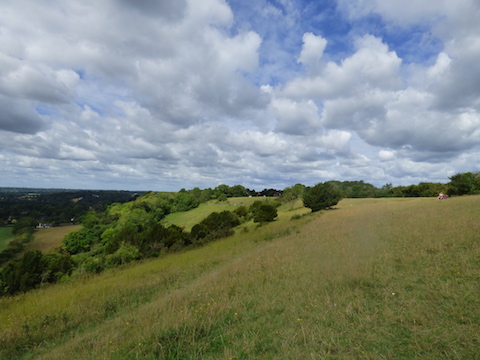
Looking west across Pewley Down.
To this day, it continues be enjoyed by visitors with its carefully managed chalk grassland and wonderful views.
During the second half of the 19th century, Guildford expanded, from the town centre outwards, like never before. Particularly on the south side that offered stunning views over the open countryside, in areas including Guildown and Warwick’s Bench. These were homes of the wealthy, while at the same time Charlotteville and land off the London and Epsom Roads were also developed for housing.
Back then there was little public open space, although the Castle Grounds were created within the castle ruins and opened as a public space in 1888.

A 1900s postcard view from Warwick’s Bench, then being developed for housing,
People rambled freely over the countryside close to and also beyond the town. Countryside that was in the hands of local landowners, such as the Onslows, Brays and Godwin-Austen families and the Poyle Estate. However, by the turn of the 20th century some of these places close to the town centre were being denied to people simply because they were being built on.

Real photographic postcard view from the 1900s looking east along Warwick’s Bench, then being developed for upmarket homes.
Fears began to be raised with letters in the local press by readers at the ‘over development’ taking place and in 1906 the first suggestion was made to save Pewley Down from development, although it wasn’t known by that name at the time.
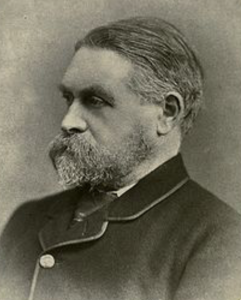
Lt-Col Henry Haversham Godwin-Austen.
On June 16, 1906 the Surrey Advertiser and County Times published a story and letter under the heading ‘Guildford and the Warwick’s Bench Estate’.
It began: “We publish a letter from Lt-Col Godwin-Austen, the subject-matter of which, we venture to think, cannot fail to be of great interest to a very large number of readers.
“The Warwick’s Bench estate is known to all who know Guildford. Until a very few years ago there was not a house upon it and the public were free to roam at will over the turf that carpets the Downs and enjoy un-obstructed views over the beautiful landscapes which make the eye at every turn.
“The hill in the vicinity of the fort has been a favourite walk with the people of Guildford for many years, not alone for the magnificent prospects it affords towards St Martha’s, Hindhead, Blackdown, and the South Downs, Charterhouse, St Catherine’s and the Hog’s Back, but also for the health-giving breezes which blow across its summit.
“Within the last eight or 10 years, as a readers are aware, the estate has been opened up for building purposes and the freedom which the public had hitherto enjoyed has been gradually curtailed. Houses of a high-class character have sprung up and at the present moment the development of the estate is proceeding more rapidly than ever and the public are being excluded more and more from parts of the Downs where they formerly wandered without let or hindrance.
“The process, however inevitable, has been regarded with very general regret, and that regret has been increased by the evidences to be seen by all who visit the hill that before long many other portions of the land will be closed to them. A new road has been cut in the chalk, running along the boundary of the fort, and is now being extended in an easterly direction.”
The fort mentioned was Pewley Fort, one of the military mobilisations centres that had been built along the North Downs in the 19th century. That is now built on, but Henley Fort exists on The Mount and has long been used a recreation and education centre for young people.
The newspaper article then printed Lt-Col Godwin-Austen’s long letter, part of it included: “Although there are many who must see what is coming, who also deplore this change from rural character into that of the suburban, with the extinction of all open spaces, yet it must be said that the town of Guildford is silent. Such being the case, I am constrained to write this letter. It will direct the attention of all classes to the subject, for without the support of public opinion its representatives cannot act. At the same time it will show what value Guildford sets on natural beauty situated so close to its very centre.”
The article included a map showing the area that Lt-Col Godwin-Austen suggested should be saved from development. It included the area extending above Fort Road and along the top of what he called the Chalk Pit Field.
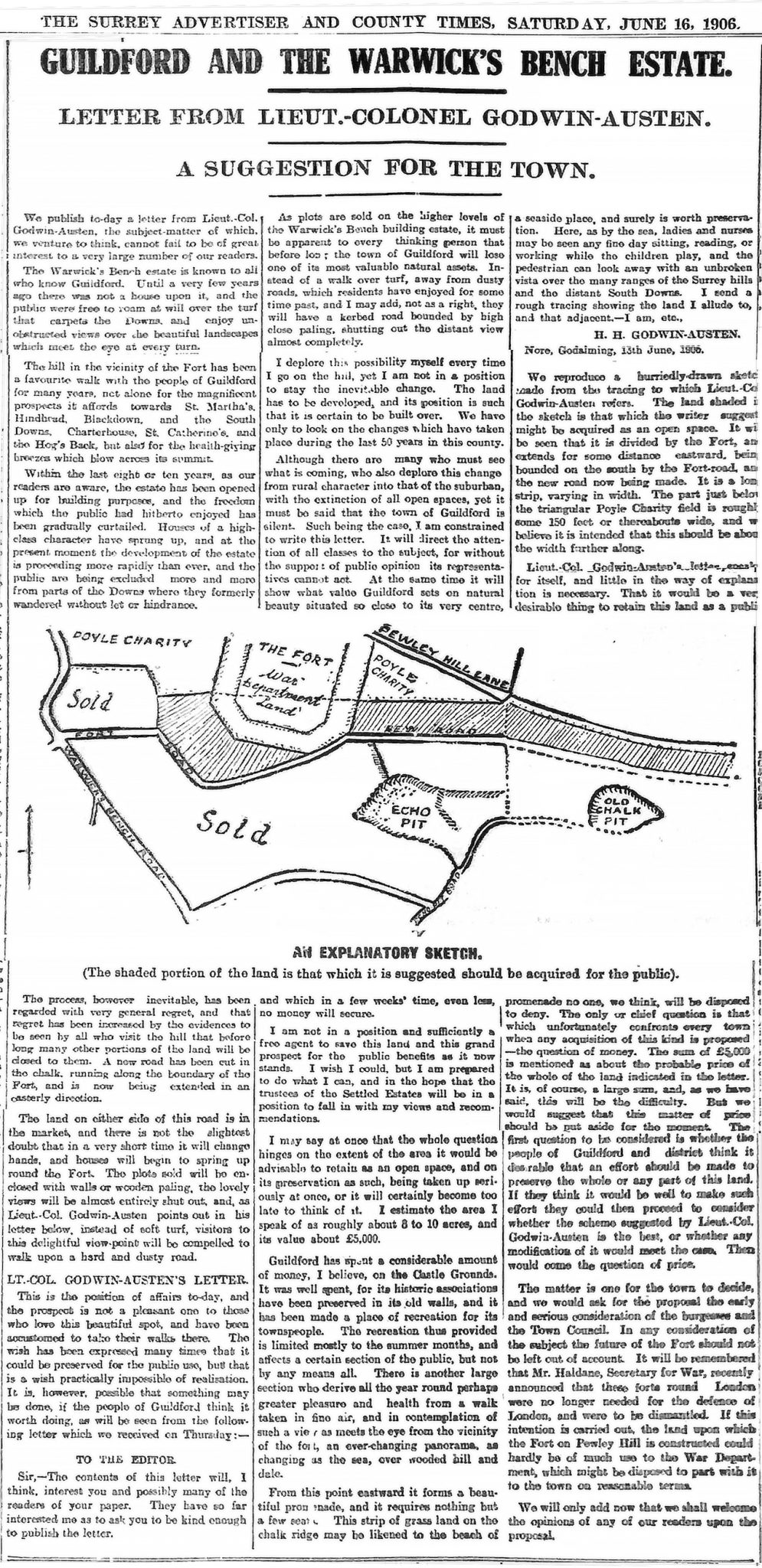
The Surrey Advertiser and County Times’ 1906 article and letter from Lt-Col Henry Haversham Godwin-Austen. Click to enlarge in a new window.
He noted that he wasn’t able to save the land himself but indicated he would do what he could and estimated the value of the land (some eight to 10 acres) was valued at £5,000.
The land was part of the Shalford Estate that he actually owned! The estate had been declared bankrupt and was being administered by a trust that legally required full market value for land sold.
Lieutenant Colonel Henry Haversham Godwin-Austen (1834-1923) is remembered as an English topographer, geologist, naturalist and surveyor. He explored the mountains in the Himalayas and surveyed the glaciers at the base of K2, also known as Mount Godwin-Austen.
He was possibly Britain’s first Buddhist convert, and at the time he wrote his letter to the Advertiser he lived at a house at the Nore, Hascombe near Godalming.
Educated at Guildford’s Royal Grammar School, he attended Sandhurst for his military training and was commissioned into the 24th Foot Regiment and saw action in the Second Anglo-Burmese War.
In 1856 he joined the trigonometry survey of India and began to work in Kashmir. He was appointed to the Survey of India the following year, retiring from the post in 1877, when he returned to England.
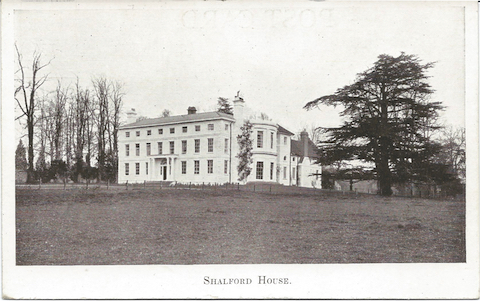
Shalford House, demolished in 1967 to make way for a water extraction and treatment works, now operated by Thames Water. After Lt-Col Henry Haversham Godwin-Austen moved out of the house due to bankruptcy it was let briefly as a boys’ school, then as the Shalford Park Hotel until 1936. Guildford Borough Council bought Shalford House and the park from the Godwin-Austen estate in December 1938. It was leased to Cornhill Insurance when the firm moved from London shortly before the Second World War.
Upon the death of his father in 1884, he inherited the family estate centred around Shalford, and appears to have lived for a while at Shalford House (demolished in 1967 and now the site of a Thames Water plant directly behind Shalford’s St Mary’s Church).
However, he had run into financial difficulties and was declared bankrupt in 1898.
Despite his suggestion regarding the land under threat of development, it would appear that no-one came forward offering to buy it and to save it as a public open space. The proposal was revived in 1907. However, by that time the land along Fort Road had been sold, but ‘Pewley Down’ was offered as a potential site.
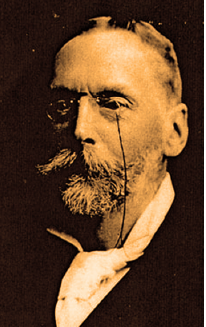
Ralph Nevill.
Renowned local architect Ralph Nevill responded to the initial offer and suggested that the whole, rather than just part, of the Chalk Pit Field would be a preferable area. This he called ‘Pewley Down’ and that may be the first recorded use of the name. He also suggested that local people might club together to buy the land.
Pewley means ‘Poyle-Lea’.
The ancient manor of Poyle takes its name from its lord of the manor during the time of Henry VIII. In the king’s personal entourage was Thomas de la Puille, who held his estate from the Crown under feudal rights.
In 1627, in his will, Surrey philanthropist Henry Smith gave £1,000 to the trustees of the poor in Guildford to buy land in which to raise money to help those in need.
They bought land of the Poyle estate, as well as land where the town mills were situated. The name lives on today with the Guildford Poyle Charities.
Lea means a piece of arable land, usually a meadow.
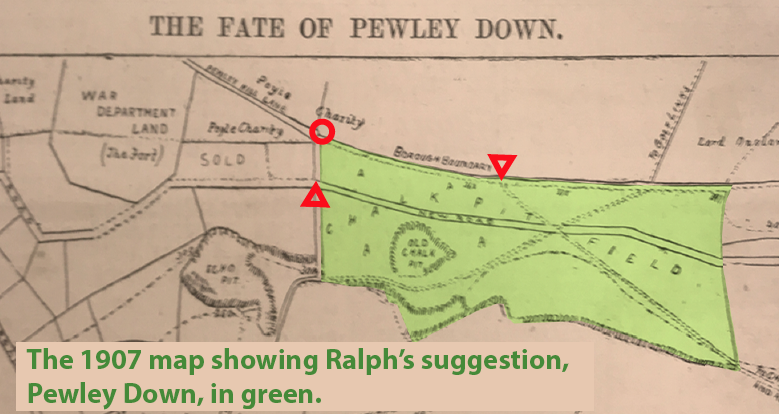
Map showing Ralph Nevill’s suggestion for the area to be created as a public open space and called Pewley Down. Click on image to enlarge in a new window.
In 1912 there was a third attempt to save the open space, but it came to nothing and soon Britain would be plunged into the First World War. However, this meant the land remained un-sold and building work in effect was halted.
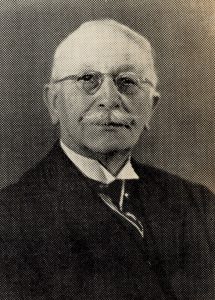
W. S. Tavener, Mayor of Guildford 1918-1920.
At a special meeting of Guildford Town Council on October 12, 1919, the Mayor, Cllr William S. Tavener (who owned a chemist’s shop in the High Street), read a letter from the chairman of Guildford’s Friary, Holroyd & Healy’s Brewery, Charles Hoskins Master.
Mr Master stated that the shareholders of the company wished to express in some substantial way their feelings of thankfulness for the successful conclusion of the war. They had passed a resolution that the company should purchase the part of Pewley Down, shown on a plan which accompanied the letter, and should present it to the town to be dedicated for all time to the use of the public.
In the council chamber the offer was received with loud applause, and on the motion of the Mayor, seconded by Alderman Leonard Ellis, and supported by Alderman W. T. Patrick, a hearty vote of thanks was passed to the Friary Brewery.
In fact, Mr Ellis and other councillors had been interested in the idea of the council purchasing Pewley Down back in 1906, 1907 and 1912, but each time the council had decided it was too expensive to justify.
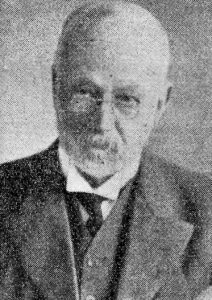
The chairman of the Friary, Holroyd & Healy’s Brewery, Charles Hoskins Master, came from a wealthy east Surrey family. Although he trained to be a barrister, in 1873 he went into partnership with Guildford brewer Thomas Taunton who had established the Friary Brewery in 1865. But within six months Master had bought Taunton out. Master then began to develop the Friary Brewery making it Guildford’s largest. The Friary Brewery purchased Holroyd’s Brewery of Byfleet in 1889 and Healy’s Brewery of Chertsey in 1890. It later bought a number of other local breweries. He held the office of High Sheriff of Surrey and retired as chairman of his brewery in 1929 and was succeeded by his son. The family home was Barrow Green House in Oxted. In 1923 he gifted a piece of land in Oxted to be a public open space. It is called Master Park.
Once the sale of the land had been completed, the formal hand over took place at a special meeting of the town council on Thursday, July 29, 1920, with the directors of the brewery and its chairman, Charles Hoskins Master, in attendance.
In a long and detailed report of the meeting, the Surrey Advertiser and County Times, noted: “Mr Master then handed the deed of conveyance to the Mayor, saying: ‘I beg to hand you this conveyance, and it is given to you as trustee for the benefit of all dwellers in Guildford, so that the 21 and three quarters acres of Pewley Down may be preserved for time immemorial as a playground for the people of Guildford, and I trust when they look further afield on these beaming valleys they will feel grateful that those valleys have been spared from the intrusive foot of the invader.’”
In his reply, the Mayor said it was a spot which Guildford had for many years desired to preserve, and one which undoubtedly was of the finest viewpoints in the whole of Surrey.
He said he remembered the previous October, when he moved the resolution accepting the offer of the company, with Alderman Ellis, in seconding, quoted the remark that no “fresher air nor cleaner sunlight lies on any Surrey down than here”.
The report also noted that a framed and illuminated copy of the resolution was presented by the council to the directors of the brewery, “who were subsequently entertained to a complimentary luncheon by the mayor at Bretts,” a restaurant in the High Street where WH Smith is today.
The illuminated copy of the resolution was the work of a Mr W. J. Harris of Sandfield Terrace. His father, William, was a cellar-man at the Friary Brewery for 40 years.
In returning his thanks to the council for the item, Mr Master said that he knew Mr Harris [senior], who “was a most cheerful man and was fond of quoting Latin”.
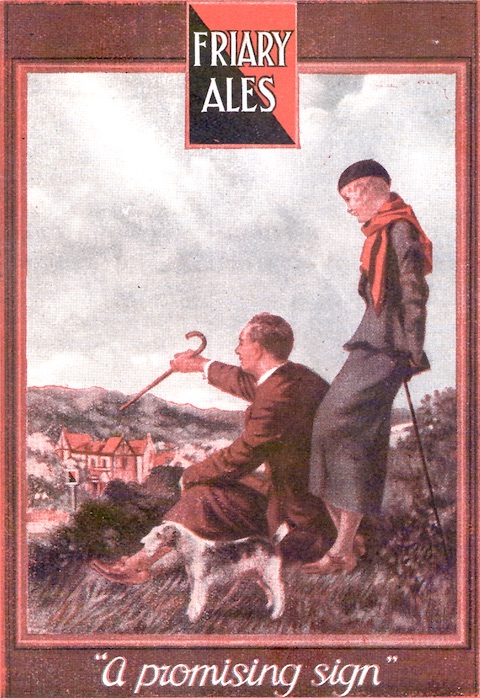
A Friary Brewery advertisement (coloured duo-tone process) from about the 1920s championing a visit to the local countryside for its beautiful scenery, and in this case not far from a Friary pub!
In 1921 a stone pedestal mounted on steps was erected on Pewley Down, with the inscription: “Pewley Down This Down was presented to Guildford by the Friary Brewery in thankfulness for the conclusion of the Great War to be preserved as an open space for ever”.
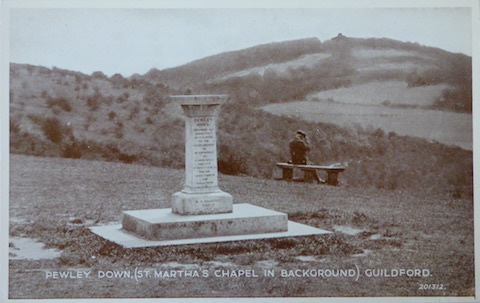
A picture postcard view of Pewley Down showing the original stone pedestal.
On the top was placed a brass plaque with names of places and features on the surrounding horizons, such as Chobham Ridges, Foxhills, Blackdown, Hurtwood, Charterhouse, and the Crystal Palace, and the distance they were away in miles.
The pedestal was ‘christened” on November 23, 1921, by then then Mayoress, Mrs Harvey Lunn.
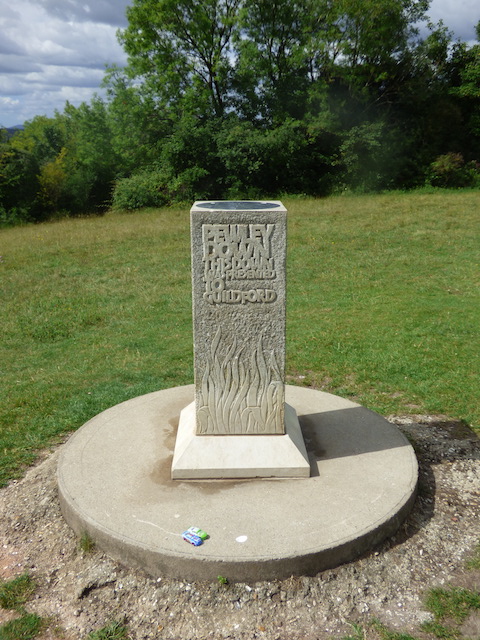
The replacement stone pedestal on Pewley Down today.
Sadly, it was vandalised some years ago, but replaced by a new stone pedestal and plaque with the same inscription.
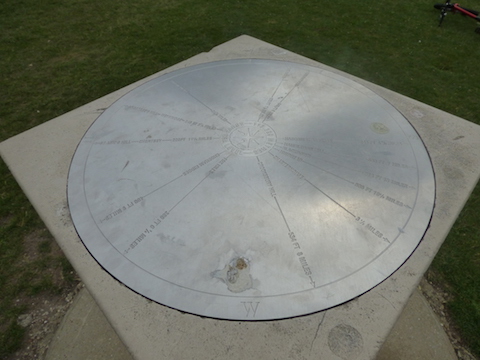
The plaque on the top of the plinth with points of interest on the horizons around. Tree growth in recent years means a number of the points of interest are no longer visible.
Today, Pewley Down is in the care of Guildford Borough Council’s countryside department with the assistance of the very active conservation group, the Pewley Down Volunteers.
In 2003, local residents formed the group, and in July 2006 the site was designated as a Local Nature Reserve.
The group points out that Pewley Down has continued to be a valuable site of recreation for the people of Guildford. Dog walkers are welcome, with poo bins at each exit.
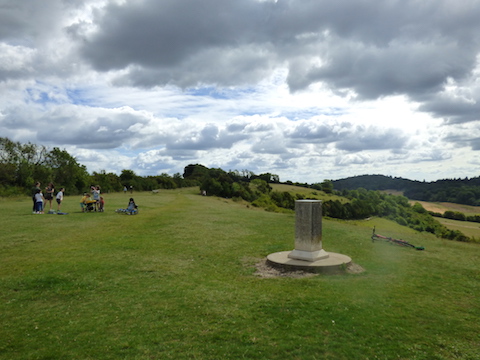
Pewley Down, looking east.
However, the loss of more than 80% of Britain’s chalk downland since the Second World War, mainly due to agricultural intensification, has highlighted the importance of Pewley Down for nationally threatened wildlife species.
They add that chalk downland is one of the richest habitats in Britain with species which are found nowhere else.
The dry climate and lack of fertility supports a high diversity of fine-bladed grasses and low growing flowers such as quaking grass, basil thyme, scabious, bird’s-foot trefoil, salad burnet, kidney and horseshoe vetches, and pyramidal and man orchids.
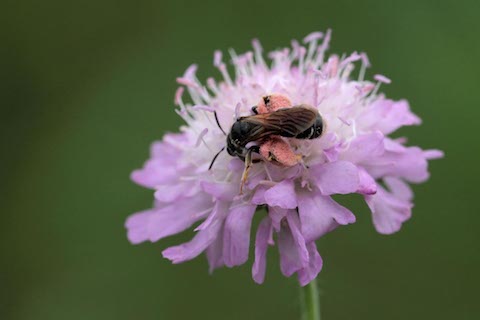
Large scabious mining bee on a scabious flower. Picture by Jonathan Mitchell.
This rich flora supports a wide variety of invertebrates, which includes more than 30 species of butterfly, more than 500 species of moth and more than 80 species of bee.

Grizzled skipper butterfly. Picture by Jonathan Mitchell.
Butterflies include important populations of small and chalkhill blues, green and brown hairstreaks, and dingy and grizzled skippers. rare moths, such as the campanula pug, have been recorded and on warm summer nights the lights of glow worms can be seen.
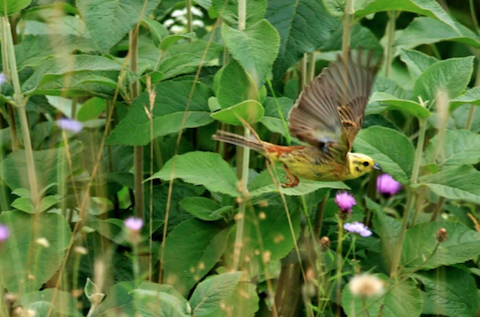
Yellowhammer in flight on Pewley Down. Picture by Malcolm Fincham.
Despite national declines, yellowhammers and skylarks can still be heard singing, and the surrounding hedgerows support dormice.
The volunteers usually meet monthly to clear scrub, clear litter and monitor the wildlife. Small areas of the Down are manually dug to the underlying chalk to create the bare ground needed by kidney vetch, the sole plant of the small blue butterfly. Historically this would have been achieved by the hooves of grazing livestock.
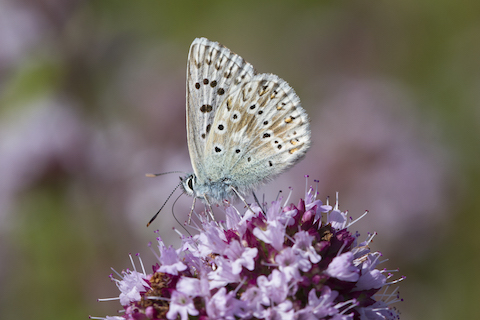
Chalkhill blue butterfly. Picture by Jonathan Mitchell.
The conservation volunteers perform a site-wide count of pyramidal orchids in July and of chalkhill blue butterflies in August. The maximum counts have been 5,979 and 4,075 respectively. In addition, a weekly butterfly transect count is performed as part of the UK Butterfly Monitoring Scheme.
The group had plans to celebrate Pewly Down’s centenary, but unfortunately these had to be cancelled to the coronavirus. Events would have involved Holy Trinity Pewley Down School, Holy Trinity Church, local dignitaries, descendants of some of those originally involved in the gifting of the site, Guildford Borough Council’s countryside team, the conservation volunteers and the people of Guildford.
It has asked that anyone who would like to mark the centenary is very welcome to pin a card or message on the main notice board on Pewley Down.
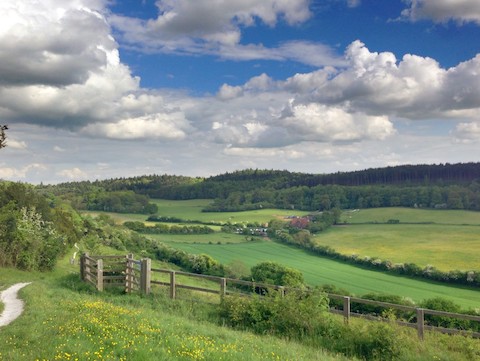
View from Pewley Down looking towards the Chantries. Picture by Jonathan Mitchell.
My thanks go to my good friend Jonathan Mitchell of the Pewley Down Conservation Volunteers for some of the historical details and its natural history, in particular for copies he made of the Surrey Advertiser reports. He and I have been corresponding on the history of Pewley Down for several years.
Other sources include the book Guildford in the Great War by William Oakley, Guildford A Short History by Matthew Alexander, who also helped with the definition of ‘Pewley’. While the details on Lieutenant Colonel Henry Haversham Godwin-Austen have been gleaned from Wikipedia.
And for more details about Shalford House and the Austen and Godwin-Austens, see local historian Margaret Dierden’s excellent 2012 article on the Shalford Village website.
Responses to The Story Of Pewley Down Gifted To Guildford 100 Years Ago
Leave a Comment Cancel replyPlease see our comments policy. All comments are moderated and may take time to appear. Full names, or at least initial and surname, must be given.
Recent Articles
- Notices: Flat Life Exhibition – New House Art Space
- Highways Bulletin: Feet First into Road Safety for Children
- Elmbridge Leader Remains Upbeat as Council Faces Its Impending Demise
- City’s Match Called Off
- Another Surrey Council Leader Bids Adieu
- Three Wins in a Row for the Flames
- Pedestrian in His 20s Dies After New Year’s Day Collision
- Guildford Flames Give Devils a Hellish Time
- Snow Forecast to Arrive with 2026 – Yellow Weather Warnings Issued
- Letter: Happy New Year to All at Guildford City FC



Recent Comments
- Tony Harrison on Letter: Progress Has Slowed on Guildford’s Station Development for Reasons Not Made Public
- Laurie Stockton on Making History As Pewley School’s Class of ’54 Hold Their Final Reunion
- William Francis on ‘Christmas Under the Rubble’ Vigil Held for Palestine on the High Street
- Jim Allen on Snow Forecast to Arrive with 2026 – Yellow Weather Warnings Issued
- Jane Hill on Letter: GBC Tenants Should Be Safe – Money Is Not the Issue
- Jane Hill on Letter: There Are Many Lessons to Learn from GBC’s Mismanagement
Search in Site
Media Gallery
Cllr Townsend on Waverley’s CIL Issue
August 27, 2025 / Comments Off on Cllr Townsend on Waverley’s CIL Issue / Read MoreMP Zöe Franklin Reviews Topical Issues
August 27, 2025 / Comments Off on MP Zöe Franklin Reviews Topical Issues / Read MoreMP Hopes Thames Water Fine Will Be ‘Final Nail in Its Coffin’
August 27, 2025 / Comments Off on MP Hopes Thames Water Fine Will Be ‘Final Nail in Its Coffin’ / Read MoreNew Guildford Mayor Howard Smith
August 27, 2025 / Comments Off on New Guildford Mayor Howard Smith / Read MoreA New Scene for a Guildford Street
August 27, 2025 / Comments Off on A New Scene for a Guildford Street / Read MoreDragon Interview: Sir Jeremy Hunt MP on His Knighthood and Some Local Issues
August 27, 2025 / Comments Off on Dragon Interview: Sir Jeremy Hunt MP on His Knighthood and Some Local Issues / Read MoreDragon Interview: Paul Follows Admits He Should Not Have Used the Word ‘Skewed’
August 27, 2025 / Comments Off on Dragon Interview: Paul Follows Admits He Should Not Have Used the Word ‘Skewed’ / Read MoreDragon Interview: Will Forster MP On His Recent Visit to Ukraine
August 27, 2025 / No Comment / Read MoreDragon Interview: Fiona Davidson on the ‘Devolution’ Proposals for Surrey
August 27, 2025 / No Comment / Read More








Gavin Morgan
July 27, 2020 at 12:41 pm
Thanks for this. A great article.
As someone who walks onto Pewley Down almost every day, I found this fascinating and will enjoy seeing with new eyes.
David Middleton
July 27, 2020 at 1:53 pm
An excellent, informative feature. Well done Guildford Dragon.
Jan Messinger
July 27, 2020 at 3:02 pm
What a wonderful piece to read from David Rose. So much information. I totally agree with the sentiments within this piece.
I too hope that in 100 years time there is still to be a beautiful outdoor space for everyone to enjoy.
Guilfordians I’m sure value what they have, just hope others do too. We can’t build everywhere.
Moira MacQuaide
July 27, 2020 at 3:33 pm
Such a lot of information. Thanks to David Rose, for telling us about a lovely area of Guildford with so much history.
Regina Redpath
July 27, 2020 at 6:29 pm
A brilliant article from David Rose. Pewley is enjoyed by many thousands and yet often looks almost untouched thanks to the expert knowledge and gentle hands of the Pewley Down Volunteers and the GBC Countryside team.
Thank you Mr Rose and thank you Guildford Dragon NEWS.
Sandy Cavalier
July 27, 2020 at 9:15 pm
As someone who grew up very near Pewley Down, and played there as a child, l found this to be a really interesting article. Thank you David Rose.
Les Knight
July 28, 2020 at 11:14 am
Thanks to David Rose.
This was one of the play areas I used in the 40s. The old shelter was also well used in the 1950s, I think it was, (and not all activity is suitable for print) until it was burnt down. It was rebuilt but was not so beautiful. I think this was also burnt down, the foundation can still be seen with seats on it.
The old chalk pit was a no go area and fenced, you reached it from Fort Road on an unmade road which is now grassed over, they filled the pit in with waste from the reservoir extension the one at the top of Pewley Hill.
Tim Ellis
July 28, 2020 at 1:11 pm
Leonard Ellis also bought and gifted Racks Close to Guildford Borough in 1911, before Pewley Down was secured. Racks Close was nearly lost in the 1960s when the Council announced that they were going to build a multi-storey car park on the site.
Strong local opposition which involved Alderman Esmond Ellis managed to stop this plan, which I believe turned into the mutli-storey car park included in the re-development of the Sainsburys site.
The tract of green space from the Castle Grounds, through Racks Close and up to the open area of Pewley Down are now central features in the character of Guildford.
Colin Light
July 28, 2020 at 8:25 pm
Thank you, a very enjoyable read, though having recently moved to Fort Road, I now feel a little like “the intrusive invader” (but only fleetingly).
Pewley Down has really been a huge benefit and enjoyed by a great number of people through the recent lockdown and it’s wonderful that this area will continue to be enjoyed by future generations.
Nathan Morley
July 28, 2020 at 10:36 pm
Thank you, David, for a fascinating article. It was most interesting, especially since I walk on Pewley Down nearly every day.
It has been my ‘green lung’ for the more than 30 years that I have been privileged to live in Guildford.
And thank you also to Jonathan Mitchell for the wonderful photos, including the last one, which is my favourite.
In addition to being a designated nature reserve, the site is within the green belt and the Surrey Hills Area of Outstanding Natural Beauty.
May the site remain so in perpetuity.
Anne Wright
July 29, 2020 at 9:47 am
100 years and not out. Congratulations Pewley Down.
Mary Alexander
July 29, 2020 at 12:48 pm
Thanks to David Rose for his fascinating and valuable history of Pewley Down. The pub sign could almost show the Down!
I’d like to add a small footnote about the place-name. It was originally Yowly or Ewley Hill, meaning “ewe or sheep clearing”. The ‘P’ must have been added because the Poyle charity owned so much of the hill. This may have been as late as 1800.
The original name suggests that the chalk downs were being used for sheep grazing, which is what they are best for. This links with the woollen trade which was so important for Guildford in the middle ages and later.
Pewley Down was also the road to Dorking, along the top of the downs. On the other side of the river, Guildown [at the top of The Mount] was the road to Farnham.
Dr Mary Alexander is the former collections officer at Guildford Museum.
Sally Tobin
October 23, 2023 at 8:23 pm
My grandparents lived half way up Pewley Hill for many years and had a fabulous view over Guildford from their long garden. Pewley Down was of course a favourite walking spot and the family used to gather there for the Boxing Day hunt when that used to be a thing. An amazing sight to behold (although I’m glad it’s not still a thing in quite the same way!!)
A really interesting history of the land. Thank you and to the volunteers who preserve its beauty, appreciated from a distance now that I live in flat Cambridgeshire fenland!!